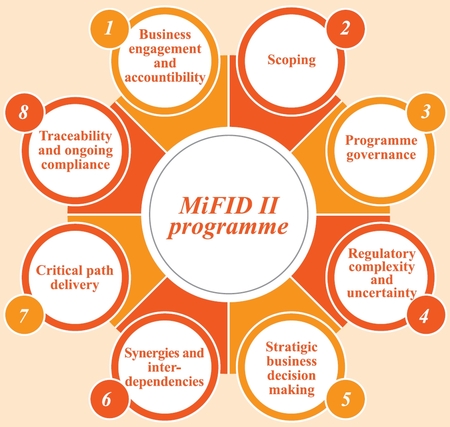
Sinead Ovenden
(i) financial intermediaries and distributors of financial products;
(ii) the financial markets and execution venues; and
(iii) the manufacturers of financial products.
The overarching objective of MiFID II is to increase transparency and strengthen investor protection. However, trading and execution venues will also be more highly regulated, developing a new type of venue, the Organised Trading Facility (OTF). Existing MiFID I transaction reporting requirements will be extended in both the types of instruments captured and data to be reported. MIFID II will implement new rules on commodity derivatives and regulations intended to make algorithmic and high-frequency trading safer.
With only one year to prepare and many details still not yet agreed or published, the temptation for many impacted firms is to wait, more so than ever due to the latest discussions in Europe to delay the implementation by a further 12 months.
However, impacted firms should start to understand the new regulatory requirements, as the impact on their business is complex and for many, quite significant. This regulatory evolution presents as much of a strategic, as it does a regulatory, shift. It will change the distribution market and potentially the service model for many providers within the industry. Consequently, completion of a detailed gap analysis early on will afford time to strategically manage the significant impact which MiFID II may have on your firm.

Clare-Ann McDermott
Overview:
The implementation complexity varies greatly across the sector. The market structure changes are highly complex and require significant technology build and investment. Some of the investor protection changes are more straight forward, such as the requirement to record telephone calls, but they too may require significant investment where such arrangements are not already in place. The MiFID II Framework encompasses three main aspects, they are:
(i) Service Model;
(ii) Product Development; and
(iii) Market Structure.
A very brief summary of the requirements is detailed below:
Service Model - The regulation will have substantial impacts on the service model of any MIFID activity. The main drivers for these impacts are:
• Inducement ban/ repayment in case of 'independent advice' or discretionary portfolio management;
• Enhanced investor information and transparency rules regarding 'cost of advice' and 'cost of products'.
• New complaint handling procedures, enhanced suitability, best execution and reporting requirements;
• Stricter transaction reporting regime for participants in the financial markets; and
• New trading and clearing obligations including asset segregation, new competition rules and obligations to clear exchange traded contracts.
Product Development: Both product manufacturers and product distributors are caught by new MiFID II requirements capturing their role during the product lifecycle. Firms need to understand when they are the manufacturer or the distributor (or both) and the different impacts this will have on their operations. ESMA defines Product manufacturer as firms that “create, develop, issue and/or design investment products”, such as an investment firm advising a corporate issuer on the launch of new securities - but not managers of UCITS/AIFs. A product distributor is a firm that offers/recommends investment products and services to clients. Both are now responsible for meeting the investor’s needs, one in the design process and the other in the distribution process.
The guidelines prescribe a set of requirements regarding:
• the governance of the product manufacturing process (i.e. how is a product created);
• the definition of product target markets (i.e. strategy, risk level, cost and performance); and
• the obligation to create, maintain and provide the product information to distributors and investors.
Market structure: The third pillar of MiFID II is the enhanced provisions regarding Market activities. These provisions are focused on the following:
• Equities must be traded on Regulated Markets or Multi-lateral trading facilities;
• Introduction of a harmonised position limits regime for commodity derivatives to improve transparency, support orderly pricing and prevent market abuse;
• Introduces new multilateral, discretionary trading venue, OTF, for non-equity instruments;
• Expands scope of Systematic Internaliser (SI) category with increased transparency requirements; and
• Imposes trading and risk controls for firms employing algorithmic trading or high frequency trading (HFT), offering direct electronic access (DEA) to clients or operating market making algorithms.
Steps to compliance
Every business should complete a detailed gap analysis to assess the potential impact on their business. The gap analysis should initially be based on Level 1 requirements but it is important to keep an eye on consultation papers and Level 2 requirements as they are published. This gap analysis stage has taken our clients anything from 6 weeks to several months depending on the size of the firm. Some further tips in relation to MIFID II implementation are detailed below and further outlined in Fig 1:
1) Ensure business engagement and accountability
Boards and business teams should understand the implications and take responsibility for implementing MiFID II. This will ensure that the strategic issues are fully addressed, as they will be directly responsible for dealing with the regulator and demonstrating compliance.
(2) Build implementation plans around strategic analysis
The starting point for implementation is determining what business to focus on in this new marketplace and what operational capabilities need to be put in place to deliver. With so many of the details still to be ironed out, your business will need to make a number of working assumptions as part of your strategic appraisal.
(3) Determine a realistic timeline and critical path for implementation
While the overall timeline will vary from business to business, our research and work with clients indicates that upgrading IT will take the most time and require the biggest slice of investment. To determine when to get full implementation underway, it’s important to work backwards from the time needed to plan, design and construct systems changes. Testing alone can take several months.
Identify and capitalise on synergies and dependencies with other changes
The MiFID II demands have considerable overlaps with other regulatory developments, especially the European Market Infrastructure Regulation (EMIR) and Dodd-Frank Act. For example it may be relatively easy to re-assign the trade flow documentation created for Dodd-Frank for use in MiFID II. These synergies and dependencies underline the importance of looking at the securities reporting and infrastructure changes in the round, rather than dealing with MiFID II in isolation.
Implementation timeline
The European Commission is currently lobbying for a one year delay in relation to the January 2017 implementation date due to the massive technology implementation requirements and the delay to publication of the Level 2 and Level 3 requirements. The current view is that one extra year is required for successful implementation of all aspects of MIFID II but there is also political pressure to go ahead with current timelines for some of the investor protection aspects.
Remember that the possible delay in start date shouldn’t be a cue to take your foot off the gas. The extra year would give you a reasonable chance of implementing MiFID II in a controlled manner and putting in place the necessary strategic changes.

